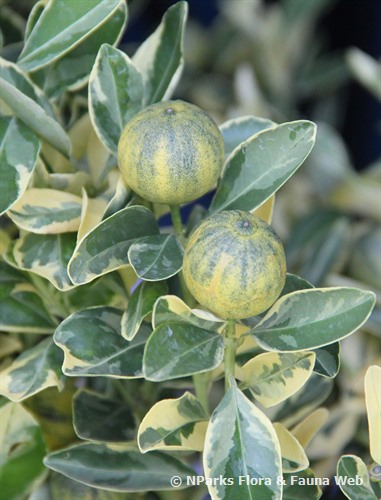
Back
Citrus medica L.
| Family Name: | Rutaceae |
| Common Name: | Fingered Citron, Buddha's Fingers, Buddha's Hand, 佛手, 香橼 |
Name
Classifications and Characteristics
| Plant Division | Angiosperms (Flowering Seed Plants) (Dicotyledon) |
|---|---|
| Plant Growth Form | Tree |
| Lifespan (in Singapore) | Perennial |
| Mode of Nutrition | Autotrophic |
| Plant Shape | Shrubby |
| Maximum Height | 3 m |
Biogeography
| Native Distribution | India |
|---|---|
| Native Habitat | Terrestrial |
| Preferred Climate Zone | Tropical, Sub-Tropical / Monsoonal |
| Local Conservation Status | Non-native (Horticultural / Cultivated Only) |
Description and Ethnobotany
| Growth Form | Small, shrubby tree up to 3 m tall. |
|---|---|
| Foliage | Large, oblong leaves have wavy leaf margins. The leaf blade bulges between the veins, creating a wrinkled surface. |
| Flowers | White, star-shaped flowers are composed of about 7 narrow, linear petals and a cluster of long, white stamens. |
| Fruit | Golden fruits have finger-like projections that resemble a hand (15-30 cm long). The fruit lacks pulp or seeds and is filled with a white, spongy tissue known as albedo. Immature fruits are purplish to dark brown. |
| Cultivation | When grown in a large container, this cultivar grows up to 0.3-0.9 m tall. |
| Ethnobotanical Uses | Edible Plant Parts : Edible Fruits Food (Fruit or Vegetable): The mature rind is very fragrant and smells like violets or osmanthus. Medicinal: According to traditional Chinese medicine, the immature fruit peel can be used to make a tonic. Cultural / Religious: In China, the fruit symbolizes longevity and happiness. In Japan, the fruits are thought to bring good luck and are given as gifts during the New Year. |
Landscaping Features
| Desirable Plant Features | Ornamental Fruits, Fragrant (Fruits) |
|---|---|
| Landscape Uses | General, Container Planting, Suitable for Bonsai |
| Thematic Landscaping | Fragrant / Aromatherapy Garden, Economic Garden |
| Usage Hazard - Cons | Spines/Thorns - Stem/Branch |
Plant Care and Propagation
| Light Preference | Full Sun |
|---|---|
| Water Preference | Moderate Water |
| Plant Growth Rate | Fast to Moderate |
| Rootzone Tolerance | Moist Soils, Well-Drained Soils |
| Propagation Method | Seed, Stem Cutting (Semi-Hardwood), Leaf Cutting |
Foliar
| Foliage Retention | Evergreen |
|---|---|
| Mature Foliage Colour(s) | Green |
| Mature Foliage Texture(s) | Leathery |
| Prominent Young Flush Colour(s) | Purple |
| Foliar Type | Simple / Unifoliate |
| Foliar Arrangement Along Stem | Alternate |
| Foliar Attachment to Stem | Petiolate |
| Foliar Shape(s) | Non-Palm Foliage (Oblong) |
| Foliar Venation | Pinnate / Net |
| Foliar Margin | Serrate / Toothed |
| Foliar Apex - Tip | Acute |
| Foliar Base | Acute |
Floral (Angiosperm)
| Flower & Plant Sexuality | Unisexual & Bisexual Flowers(Sub-dioecious) |
| Flower Colour(s) | Pink, White |
|---|---|
| Flower Texture(s) | Smooth, Gloss / Shiny |
| Flower Grouping | Solitary, Cluster / Inflorescence |
| Flower Location | Axillary |
| Inflorescence Type | Raceme |
| Flowering Period | Free-Flowering |
Fruit, Seed and Spore
| Mature Fruit Colour(s) | Yellow / Golden |
|---|---|
| Mature Fruit Texture(s) | Rough, Bumpy / Tuberculate |
| Fruit Classification | Simple Fruit |
| Fruit Type | |
| Seed Quantity Per Fruit | Few (1-5) |
Image Repository
Others
| Master ID | 30847 |
|---|---|
| Species ID | 5217 |
| Flora Disclaimer | The information in this website has been compiled from reliable sources, such as reference works on medicinal plants. It is not a substitute for medical advice or treatment and NParks does not purport to provide any medical advice. Readers should always consult his/her physician before using or consuming a plant for medicinal purposes. |









